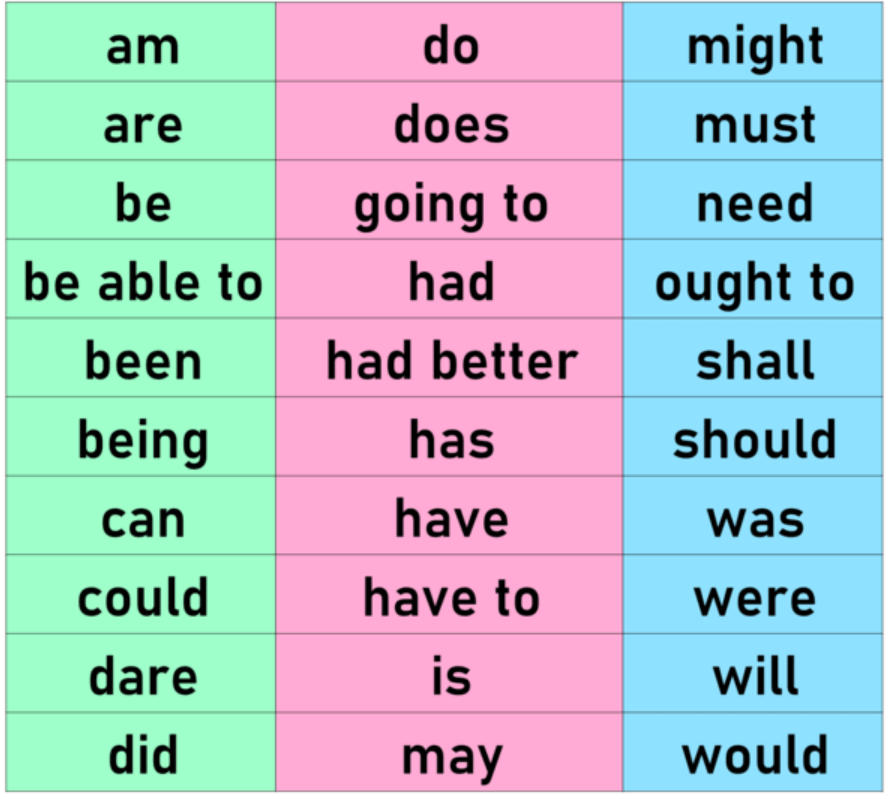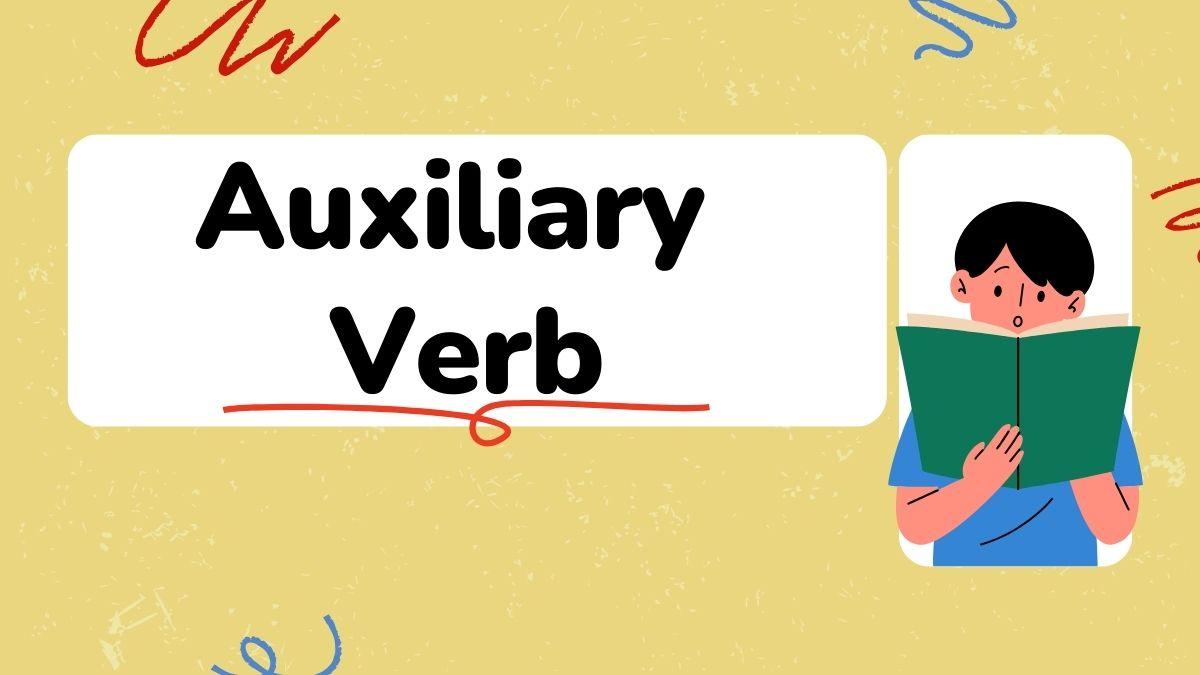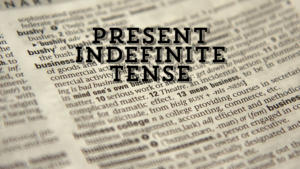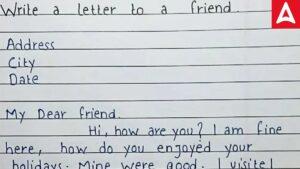Table of Contents
Auxiliary Verb
Auxiliary verbs, also known as helper verbs or helping verbs, work alongside the primary verb in a phrase to convey difficult grammatical concepts such as modalities or time aspects. For example, the auxiliary verb “finished the report” assists the main verb in finishing the phrase.
Because these verbs might be tricky to understand for many students, we’ve provided all of the information you’ll need here. We have also given actual examples of common helping verbs and have explained when and how to use them in English grammar.
What is an Auxiliary Verb?
Auxiliary verbs offer a supporting role in the main sentence, after the principal verb. They are mostly used to construct complex grammatical tenses, like as the perfect and continuous tenses, which reflect many aspects of time or the duration of an action.
As an example:
I enjoy studying. (Present Simple).
I’m going to have some fun. (Present Continuous).
The first sentence in the preceding instances does not require an helper verb since these verbs are not used in simple/indefinite tense. However, in the second sentence, the helping verb ‘am’ is employed since, aside from simple tenses, all tenses require an auxiliary verb to support the primary verb.
Modal Auxiliary Verb
According to the Oxford Learners’ Dictionary, an auxiliary verb is “a verb such as be, do, and have used with main verbs to demonstrate tense, etc. and to construct questions, and negatives.”
Modal Auxiliary verbs are “the verbs ‘be’, ‘do’, and ‘have’ in English, when they are employed with another verb to construct tenses, questions, question tags, and the passive,” according to the Macmillan Dictionary. Am, are, do, and has been are all auxiliaries in the sentences “I’m listening,” “Are you working,” “You don’t like her, do you?” and “The bill has been paid,” for instance.
An auxiliary verb is defined as “a verb that is employed with another verb to generate tenses, negatives, and questions” by the Cambridge Dictionary. The helping verbs in English are “be”, “have”.
Auxiliary Verb Examples
Different tasks can be accomplished by auxiliary verbs in a sentence or context. In order to change the tense, voice, and mood of a sentence, helping verbs serve as supporting verbs. Let’s see how each of these properties is met by these verbs.
Let us look at the following table to learn the uses of auxiliary verbs:
| Root Verb | Auxiliary Verb | Tense Form | Examples |
| To be | Am | Present Continuous (Singular) | I am working on this project. |
| Is | Present Continuous (Singular) | He is going to market. | |
| Are | Present Continuous (Plural) | They are sleeping. | |
| Was | Past Continuous (Singular) | She was doing her work. | |
| Were | Past Continuous (Plural) | The children were playing in the park.. | |
| Have | Have | Present Perfect | They have come to India after five years. |
| Has | Present Perfect (Third person pronoun – ‘He’, ‘She’ and ‘It’) | Tharun has finally found the keys to his car. | |
| Had | Past Perfect | Neena and Vijay had brought their pet along with them when they came to have dinner with us. | |
| Have been | Present Perfect Continuous | I have been waiting for my interview results since last week. | |
| Has been | Present Perfect Continuous | Firoz has been working as a doctor in Uttar Pradesh for a year now. | |
| (Third person pronoun – ‘He’, ‘She’ and ‘It’) | |||
| Had been | Past Perfect Continuous | Heera and Diana had been waiting to visit the Museum of Fine Arts from the day they reached Bangalore. | |
| Will | Will | Simple Future | I assure you that I will finish all my assignments by Friday. |
| Will be | Future Continuous | She will be attending the Parent-Teacher meeting next week. | |
| Will have | Future Perfect | They will have reached London by this time tomorrow. |
Auxiliary Verb List
Check out the Auxiliary Verb List here. You can download this Modal helping Verb List image for future use.

Types of Auxiliary Verbs
As auxiliary verbs assist the main verb in expressing tense, mood, and voice, there are 4 types of auxiliary verbs that execute these three duties.
Auxiliary Verbs for Expressing Tense
Because these auxiliary verbs can be confused with connecting verbs, it is crucial to examine the context of the surrounding words in the phrase, or context clues, to determine which verb is being used.
As an example:
When the car accident occurred, he was thankful that he was wearing his seatbelt.
Auxiliary Verbs for Mood Expression
Auxiliary verbs that reflect mood are frequently used in phrases that pose an inquiry or issue a directive.
Here’s an example of an interrogative sentence, or one that asks a question:
Did you remember to feed the dog the day before?
Even though the noun subject separates this helping verb from the main verb, it nonetheless aids the main verb by questioning whether something was done yesterday or not.
Auxiliary Verbs for Expression of Voice
Voice can sometimes relate to a writer’s particular style, but in this context, voice refers to the distinction between active and passive voice.
When a verb is written in an active voice, the subject of the phrase performs the action.
For example, when he found himself surrounded by ravenous orcas, the lone dolphin screamed out urgently for his pod.
In this sentence, the subject, the dolphin, is carrying out the sentence’s action, which is termed.
Modality Expressing Auxiliary Verbs
The modal auxiliaries are a fourth sort of auxiliary verb that communicates possibility or ability.
Example – Remember when I said the girl wanted to color her hair? This is an example of a modal auxiliary since it demonstrates ability because she couldn’t determine which color to use.
Sure, if she had done more research or solicited opinions from her friends, she might have been able to make a decision, but as written, she was unable to do so, necessitating the addition of one of these helper verbs.
Auxiliary Verb with Example Sentences
Modal auxiliary verbs can be used with main verb instead of helping verbs but it is employed to emphasize a potential, capacity, necessity, or likelihood of an action occurring. See the samples below to get a thorough understanding of how modal auxiliary verbs function.
| Modal Auxiliary Verbs | Examples |
| Can | I can solve this sum. |
| Could | When I was young, I could swim. |
| May | You may come in the evening. |
| Might | It might rain. |
| Will | She will solve the puzzle. |
| Would | Would you like to have some coke? |
| Shall | We shall come with you. |
| Should | You should be careful. |
| Must | You must take your medicine on time. |
| Ought to | You ought to obey the rules. |
What are 24 Auxiliary verbs?
Auxiliary verbs, also known as helping verbs, are used in combination with main verbs to create different verb forms and convey various aspects of the action or state. Here are 24 common auxiliary verbs:
- Be: am, is, are, was, were, been, being Example: She is studying for her exam.
- Have: have, has, had Example: They had finished their homework.
- Do: do, does, did Example: He does his chores every day.
- Will Example: I will call you later.
- Shall Example: Shall we go to the park?
- Can Example: She can swim very well.
- Could Example: We could hear the music from the party.
- May Example: May I borrow your pen?
- Might Example: It might rain later.
- Must Example: You must complete the assignment.
- Should Example: They should arrive soon.
- Ought to Example: You ought to apologize for your mistake.
- Would Example: He would always help his friends.
- Used to Example: They used to live in that house.
- Need Example: We need to finish the project.
- Dare Example: She dared to take on the challenge.
- Going to Example: They are going to travel next week.
- Has to Example: He has to attend the meeting.
- Had better Example: You had better be on time.
- Have to Example: We have to catch the bus.
- Has got Example: She has got a new car.
- Had Example: They had seen that movie before.
- Be able to Example: I am able to solve difficult problems.
- Be going to Example: The team is going to win the match.
These helping verbs help us express tenses, moods, questions, negation, and other aspects of the verb in a sentence.
How to Identify Auxiliary verb?
You are probably aware that every sentence contains a verb of some kind.
- Verbs can be divided into two categories. Action verbs are used to describe tasks that can be completed, while linking verbs are used to explain circumstances. The three primary helper verbs—do, be, and have—can be accompanied by action verbs or connecting verbs.
- Sometimes events or circumstances only happen once before ending. In situations like this, several verbs that are often used as helping verbs are switched out for action or linking verbs. The word “is” can be seen in this illustration. This is one of the most popular auxiliary verbs, however since it stands alone in this sentence, it is not doing its intended job.
John slammed the door on Tom’s hand. He is in the pain.
In this line, “is” serves as a connecting verb. It is not an helping verb because it is a stand alone verb.
- Other times, a situation, activity, or condition is ongoing, predictable, or connected to another occurrence or series of events. In certain circumstances, phrases with helper verbs are utilized instead of single-word verbs like is because they better capture what transpired. These could contain anything between two and four words.
- A primary verb, usually referred to as a base verb, describes the nature of the activity or condition that is occurring. Auxiliary or assisting verbs are used in conjunction with the primary verb to express additional information that gives the reader more detail about the action that is taking place.
| Related Post | |
| Verb Forms | Transitive and Intransitive Verbs |
| Irregular Verbs | Modal Verbs |


 Present Indefinite Tense: Formula, Exerc...
Present Indefinite Tense: Formula, Exerc...
 Email Writing Format for Class 10- Check...
Email Writing Format for Class 10- Check...
 Letter Writing in English, Types, Tips, ...
Letter Writing in English, Types, Tips, ...































